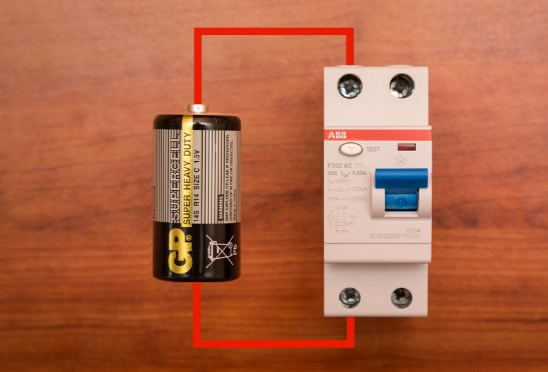What is the difference between electromechanical RCD and electronic?
Differences between devices
There are 3 fundamental differences between residual current circuit breakers. The first visual - you can determine the type of RCD by looking at the circuit, which is located on the front of the case. To begin, we recommend that you familiarize yourself with symbols on the diagrams. So, a mechanical RCD shows on the case a differential transformer with a secondary winding, a polarized relay, a trigger, a TEST button and a resistor. The electronic model has an amplifier, which is additionally connected to the supply wires.
If it’s simple - you can distinguish electronic RCD from electromechanical RCD by the presence of a triangle with the letter "A" in the circuit (amplifier). If there is a triangle, then the device is with electronics, no - mechanical type.
You can clearly see the fundamental difference in the diagram below:
The second way to determine - using a regular finger battery. Take two wires, connect one to the input terminal (top), the second bottom. The main thing is that the terminals are of the same name: either PHASE-PHASE, or ZERO-ZERO. Next, cock the lever to the "on" position (up) and connect the wires to the battery. If the lever is triggered when the battery is connected, it means an electromechanical type residual current device. Nothing happened? Change the polarity of the power source. Nothing again? In this case, the RCD is electronic.
Well, the last way to determine the apparatus is with a magnet. Pass a magnet over the body of an unconnected RCD (the main thing is that the lever is in the "on" position) and if an operation occurs, it is an electromechanical type device.
You may also be interested in reading the article - how to distinguish RCD from difavtomat.
Which is better to choose?
Important information for you will be the functional difference between electronic and electromechanical RCDs. As many have probably already understood, based on the methods for determining the type of apparatus, a device with electronics inside only works if there is voltage in the network. If there is no voltage, operation will not occur. And this is a very big drawback of electronic difavtomatov and RCD.
On the one hand, it seems that the operation should be only when the voltage is on. Sense of protection to work if there is already no light? But it makes sense, if you recall about such a danger as zero wire break. If the zero burns out in the shield, there will be no light, but the dangerous voltage will remain and if electric current leakage, electric shock cannot be avoided. At the same time, the electromechanical apparatus will work in this case.
Another disadvantage of electronic RCDs is failure during power surges. All electronics are very sensitive to overvoltage and impulse noise. As a result, the board will fail, it will seem to you that the protection device is working, but in fact it will not save when leakage current.
Based on this, it becomes clear that it is better to choose - electromechanical RCD or electronic. If you still decide to use a modern device, we strongly recommend checking it at least once a month using the "TEST" button.
Finally, we recommend watching a video that shows the fundamental differences between the devices:
Here, by such criteria, you can distinguish electronic RCD from electromechanical. We hope you now know what the difference is between devices and what is the best choice for home wiring.
It will be interesting to read:









on the photo on one it’s written 25A is an RCD, and on the other C16 is it supposed to be a difavtomat, or am I mistaken?
All is correct. Sorry, made a mistake. In fact, their circuits are very similar, so I missed this point. I deleted the photo, the scheme is correct.